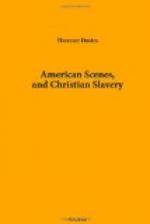In consequence of the following advertisement in the Picayune, I screwed up my feelings, and resolved for once at least in my life to see a slave-auction. I was the more disposed to attend this, as it was distinctly stated that they would be sold in families. I should not therefore have to behold the wife torn away from the husband, the husband from the wife, the parent from the child, or the child from the parent, as is so commonly done.
“COTTON-FIELD HANDS.—By Beard, Calhoun, and Co., auctioneers.—Will be sold at auction, on Friday, the 5th inst., at 12 o’clock, at Bank’s Arcade, thirty-seven Field Slaves; comprising eighteen from one plantation, and fourteen from another. All acclimated Negroes. To be sold in Families. Full particulars at sale.”
“F. 4.”
Setting off a few minutes before 12, after about half-a-dozen inquiries, and as many “guessing” answers, I found “Bank’s Arcade.” It was very near the Presbyterian church, in which I had heard such excellent sermons on the preceding Sabbath. It was a large open building: one side occupied as a bar for the retail of strong drinks, and the other fitted up for auctioneering purposes,—there being conveniences for three or four of the trade to exercise their vocation at the same time. One end was used for the sale of books and other publications, chiefly novels; and the other for the exhibition of fancy goods.
As I got in at one end, I heard a voice—with that peculiar, twirling, rapid, nasal twang, which marks the Transatlantic auctioneer—say, “400 dollars for this fine young woman—only 400 dollars—420, only 420—430—440, only 440 dollars offered for this fine young woman.” By this time I had got in front of the performer, and had a full view of the whole affair. And sure enough she was a “fine young woman,” about twenty-three years of age, neatly dressed, not quite——But the scene shall form the subject of my next letter.




